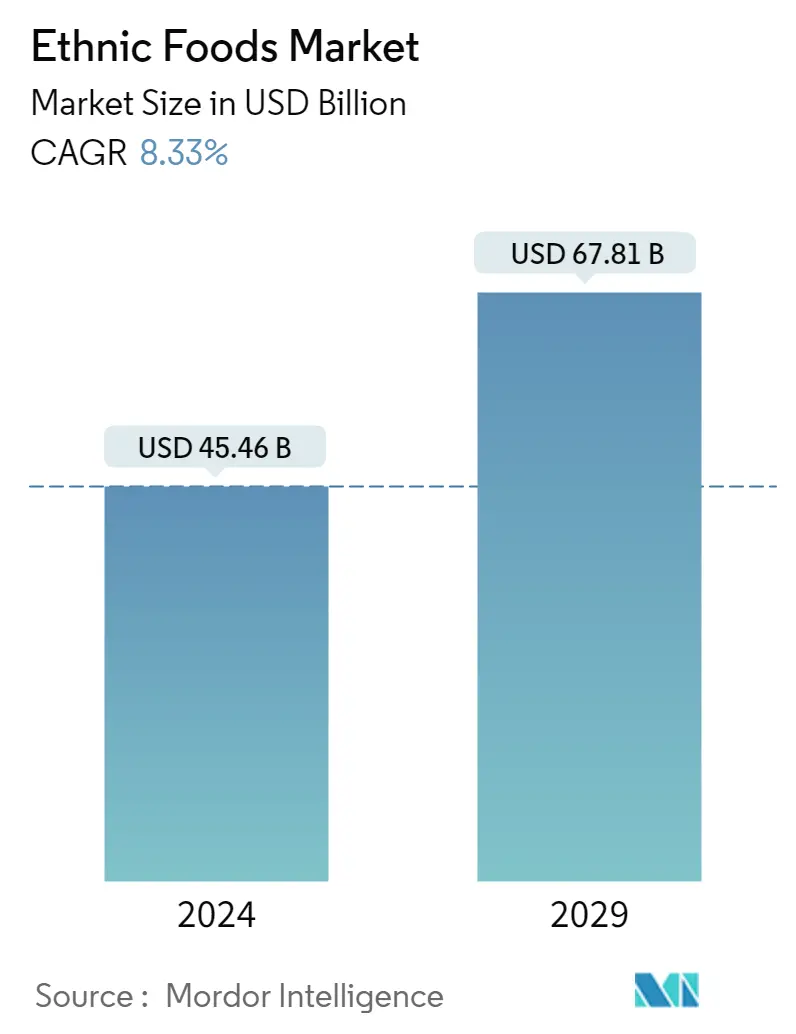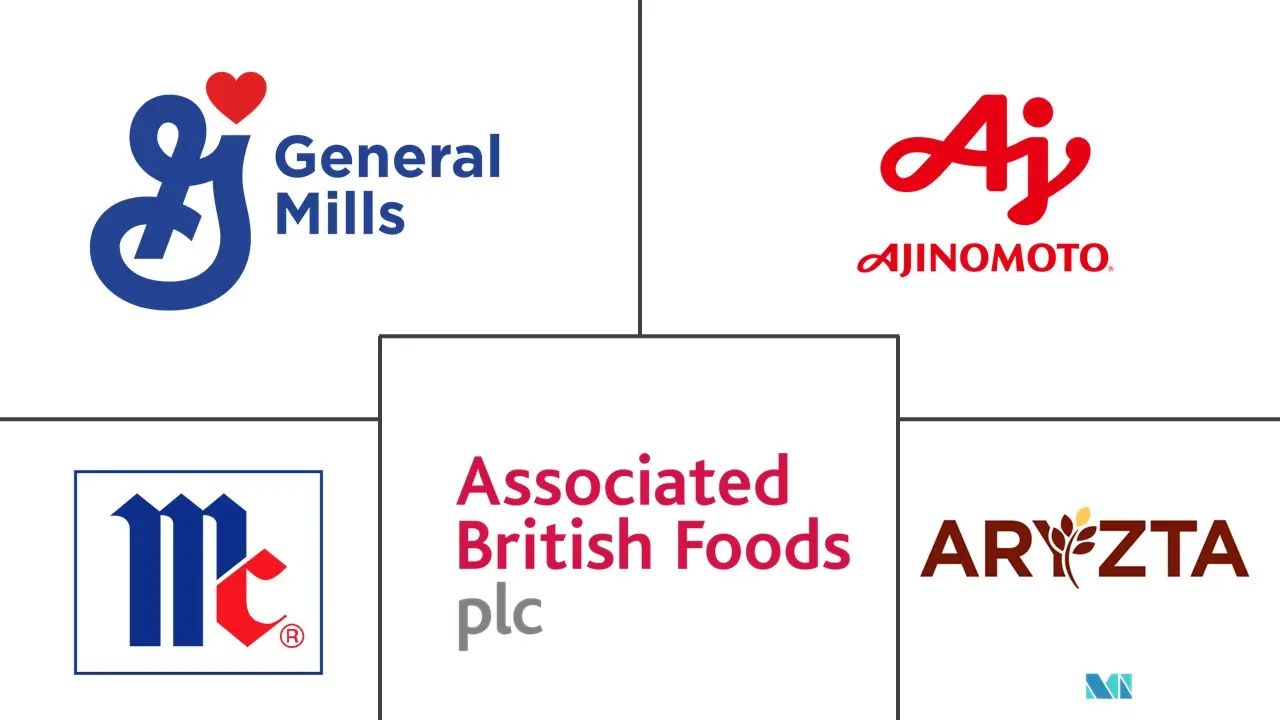Market Size of Ethnic Foods Industry

| Study Period | 2019 - 2029 |
| Market Size (2024) | USD 45.46 Billion |
| Market Size (2029) | USD 67.81 Billion |
| CAGR (2024 - 2029) | 8.33 % |
| Fastest Growing Market | Europe |
| Largest Market | North America |
| Market Concentration | Low |
Major Players
*Disclaimer: Major Players sorted in no particular order |
Ethnic Food Market Analysis
The Ethnic Foods Market size is estimated at USD 45.46 billion in 2024, and is expected to reach USD 67.81 billion by 2029, growing at a CAGR of 8.33% during the forecast period (2024-2029).
Post-COVID-19, consumers moderately increased the intake of a variety of ready-to-eat food products, which come from various ethnicities and are popularly demanded across the world, driving the demand for ethnic foods during the current year.
With the growing immigration rates due to employment opportunities, higher education, and tourism, the demand for ethnic food has been increasing, and over the medium term, with the increasing consumption of nutritious food and rising capital investment in producing healthy, ethnic-based food, the market studied is expected to gain traction over the forecast period.
One factor driving ethnic food demand is the availability and accessibility of ethnic food items through specialized ethnic food supermarket chains. Developing countries are experiencing an increase in westernization, which is changing people's tastes and preferences. It is becoming more popular to eat out, and more people are interested in trying intercontinental and exotic foods. Food is becoming more therapeutic as a result of consumers' growing preference for innovative and creative cuisines.
Moreover, ethnic food manufacturers are focusing on the convenience factor, quality of food, cuisine variants, and packaging formats of the products. The ethnic food market continues to diversify as consumers continue to experiment with new global cuisines. Some of the niche ethnic food categories include African, Indian, and Indonesian cuisines that have been growing over the recent past.
Ethnic Food Industry Segmentation
Ethnic food refers to a wide variety of packaged foodstuffs that can be identified by the public mind as coming from a foreign source.
The ethnic foods market is segmented by distribution channel into hypermarkets/supermarkets, convenience stores, online stores, and other distribution channels. By geography, the market is segmented into North America, Europe, Asia-Pacific, and Rest of the World. For each segment, the market sizing and forecasts have been done in value terms (USD million).
| Distribution Channel | |
| Supermarkets/Hypermarkets | |
| Convenience Stores | |
| Online Retail Channels | |
| Other Distribution Channels |
| Geography | |||||||||
| |||||||||
| |||||||||
| |||||||||
|
Ethnic Foods Market Size Summary
The ethnic food market is experiencing significant growth, driven by increased consumer interest in diverse and nutritious cuisines. This trend is fueled by factors such as rising immigration, globalization, and the growing popularity of intercontinental and exotic foods. Consumers are increasingly seeking bold flavors and innovative culinary experiences, which has led to a surge in demand for Asian, African, Indian, and Indonesian cuisines. The availability of ethnic food items through specialized supermarket chains and the influence of social media are further propelling this market expansion. As consumers become more adventurous with their food choices, the market is diversifying, with manufacturers focusing on convenience, quality, and varied packaging formats to meet evolving consumer preferences.
The market landscape is competitive, with major companies like Ajinomoto Co. Inc., McCormick & Company Inc., and General Mills Inc. leading the charge by offering a wide range of ethnic cuisines. These companies are expanding their product portfolios and distribution channels, particularly in supermarkets and hypermarkets, to capture a larger market share. Recent strategic moves, such as acquisitions and collaborations, highlight the industry's focus on enhancing product offerings and market presence. The Asia-Pacific region, in particular, is witnessing a surge in specialty and international food sales, driven by a young population eager to explore new culinary experiences. As the market continues to grow, it is expected to rely more on the fusion of ethnic blends, catering to the diverse tastes of both immigrant and native populations.
Ethnic Foods Market Size - Table of Contents
-
1. MARKET DYNAMICS
-
1.1 Market Drivers
-
1.2 Market Restraints
-
1.3 Porter's Five Forces Analysis
-
1.3.1 Bargaining Power of Suppliers
-
1.3.2 Bargaining Power of Buyers
-
1.3.3 Threat of New Entrants
-
1.3.4 Threat of Substitute Products
-
1.3.5 Intensity of Competitive Rivalry
-
-
-
2. MARKET SEGMENTATION
-
2.1 Distribution Channel
-
2.1.1 Supermarkets/Hypermarkets
-
2.1.2 Convenience Stores
-
2.1.3 Online Retail Channels
-
2.1.4 Other Distribution Channels
-
-
2.2 Geography
-
2.2.1 North America
-
2.2.1.1 United States
-
2.2.1.2 Canada
-
2.2.1.3 Mexico
-
2.2.1.4 Rest of North America
-
-
2.2.2 Europe
-
2.2.2.1 United Kingdom
-
2.2.2.2 Germany
-
2.2.2.3 Spain
-
2.2.2.4 France
-
2.2.2.5 Italy
-
2.2.2.6 Russia
-
2.2.2.7 Rest of Europe
-
-
2.2.3 Asia-Pacific
-
2.2.3.1 China
-
2.2.3.2 Japan
-
2.2.3.3 India
-
2.2.3.4 Australia
-
2.2.3.5 Rest of Asia-Pacific
-
-
2.2.4 Rest of the World
-
2.2.4.1 South America
-
2.2.4.2 Middle East & Africa
-
-
-
Ethnic Foods Market Size FAQs
How big is the Ethnic Foods Market?
The Ethnic Foods Market size is expected to reach USD 45.46 billion in 2024 and grow at a CAGR of 8.33% to reach USD 67.81 billion by 2029.
What is the current Ethnic Foods Market size?
In 2024, the Ethnic Foods Market size is expected to reach USD 45.46 billion.

